In the 1860s, when Rodin began making sculpture, art was deeply rooted in the past — it told stories from religion, history, myth, and literature, and it told them as if the artist had been a witness to the events. Just thirty years later, by the peak of his career — the 1890s — Auguste Rodin had transformed sculpture into something that today we call modern, that spoke to the artist’s and viewer’s emotions and imaginations. The stories that were told were often internal and conceptual, and there was no right or wrong way to interpret them. And by the time Rodin died in 1917 he had — through prodigious talent and a remarkable volume of work — challenged the established styles of his youth and revolutionized sculpture. Today his pioneering work is a crucial link between traditional and modern art.
(This section of our website gratefully acknowledges the words and ideas expressed by the following scholars: Ruth Butler, Albert Elsen, Antoinette le Normand-Romain, David Steel, and John Tancock.)
Rodin’s legacy includes:
Expressively modeled surfaces
Rodin believed that the attributes of the surface and of the contours of a piece of sculpture could help determine its emotional content and thus its impact on the viewer. Thus not only his poses but also the way he manipulated the visible surfaces of his bronzes — the rough, expressive, and light-catching modeling — represented the vitality and emotion of his subject. Additionally it’s useful to remember that his bronzes were seen in the days before constant electrical lighting. Works were either placed outside in changing light or inside in flickering candle and gaslight. Seen in such light the perceived changing character of a sculptural surface carried great potential for expression.
Examples (click on images to enlarge):
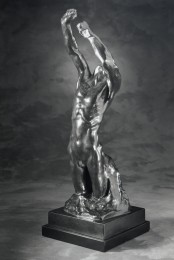 |
Despairing Adolescent
The sinuous lines of the arms stretching upward, the reverse S curve that starts at the youth’s lower hand and works its way down the left side of his body, the head leaning backward so as not to interrupt the formal importance of those arms – all of these demonstrate Rodin’s ability to use contours in service of expression. |
 |
Aphrodite (aka Venus)
Rodin fashioned Aphrodite at the request of the director of the Théâtre de la Renaissance in Paris, the actress Cora Laparcerie; it was to be a stage prop for her new play of the same name. Said Laparcerie, “In a play in which the statue of Love had the leading role,” she wanted “this statue to be executed by the greatest sculptor of the age.” She told Rodin that his works should be not only in museums and city squares, but also “down among the people…for all those who have memories of love.” The play previewed in March 1914. The press was both in favor and against Rodin’s participation, some regretting that the great sculptor had become a “theater prop man.”
That the figure, enlarged to four times its initial size for use on stage, was meant to be seen from afar is indicated by the summary treatment of the facial features and the emphasis on the contours and planes of the body rather than on the details. This figure is especially engaging when viewed from the side, where the elegant pose seems to defy gravity. |
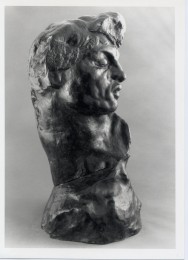 |
Head of a Shade
There are many variations of the numerous figures that Rodin detached from The Gates of Hell when the commission for the mammoth piece was canceled. Removed from atop the doors were three muscular figures, turning to each other, pointing and looking downward into the morass of Hell, which they are about to enter and of which they warn: “Abandon hope, all ye who enter here.” These are The Three Shades. Their poses, their muscles, and their expressions all speak to Rodin’s interest in Michelangelo.
As was typical of how Rodin worked, eventually the individual shades became fodder for his imagination, fueling his creative use and reuse of parts. In separating the head of the shade from its body, Rodin presents it upright and in so doing, he emphasizes expressive surfaces in new ways. Thus, this Head of a Shade has a very different mood than did its source. |
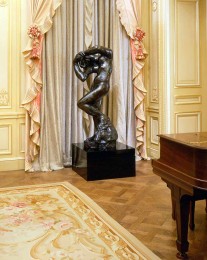 |
Meditation (with Arms)
This figure, which displays a Michelangelesque tendency to combine the masculine and the feminine, is also an amalgam of Rodin and art nouveau, the premiere avant-garde style in decorative and graphics arts during the late-Nineteenth and early-Twentieth centuries. One need only look at paintings and drawings by Klimt and Mucha to see the similarities. In the contours of Rodin’s sculpture we find the same whiplash curve and pose – essentially a reverse S-curve that starts at the top of the head and descends through the shoulder, to the left torso, then the hip, the knee and finally the heel. Even though Rodin declared himself to be independent of the styles of his day, he is sometimes betrayed by his work: Here are art nouveau tendencies; other works are infused with the Rococo Revival (see Idyll of Ixelles). Rodin’s secretary, the poet Rainer Maria Rilke, described the figure:
Again and again in his figure Rodin returned to this bending inward, to this intense listening to one’s own depth. This is seen in the wonderful figure called ‘La Meditation’…. Never before was a human body assembled to such an extent about its inner self, so bent by its own soul and yet upheld by the elastic strength of its blood. The neck, bent sidewise on the lowered body, rises and stretches and holds the listening head over the distant roar of life.
|
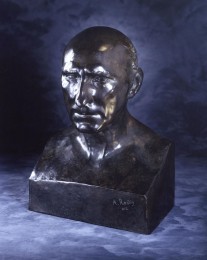 |
Bust of Jean Baptiste Rodin
Rodin’s father (1803-1883) was a conservative family man who worked hard his entire life, first as a clerk in a police station and then as a police inspector. Left a widower by his first wife, he married again and with his second wife had three children. It was a close and supportive family. Jean Baptiste Rodin seems to have been a quiet, unremarkable person. For his time and background, however, he was remarkable in one respect: He supported his son’s aspirations to be an artist. Indeed, he recognized his young son’s talent when no one else did. In an undated letter in the archives of the Musée Rodin, Jean wrote to his Auguste, giving him fatherly advice:
You must not construct your future on sand so that the smallest storm will bring it down. Build on a solid, durable foundation [so that] the day will come when one can say of you as of truly great men – the artist Auguste Rodin is dead but he lives for posterity, for the future.
In 1860 Auguste made two portraits of his father, one a painting, the other, this bust. The painting shows him in profile and as he appeared: with a bushy beard and moustache, and balding, with black hair on the back of his head. In comparison, the sculpture conveys little of the father’s real appearance except perhaps for his long nose and receding chin. What it presents instead is Rodin’s response to his father’s support. Here Jean Baptiste has the intelligence and resolve of a Roman emperor.
This 1860 bust is one of Auguste Rodin’s earliest pieces; he made it when he was twenty years old. It is based on ancient Roman sculpture he would have seen at the Louvre, which speaks to his interest at this stage of his career in following tradition, in building the “solid, durable foundation” of which his father wrote. And that it conveys with such conviction his father’s personality more than his appearance foretells the artist’s future achievements. |
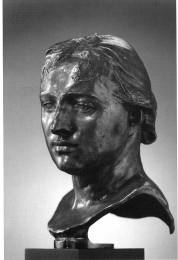 |
Bust of Mrs. Russell
Anna Maria Antoinetta (sometimes known as Marianna) Mattiocco della Torre (1865-1908) was the wife of Australian Impressionist painter John Russell. An Italian model, she had the classical features that Rodin preferred in women, and after he modeled her bust in 1888 he continued to use her face in other pieces for the next 20 years, most notably in his various figures of Minerva. Unlike Rodin’s male portraits, his female portraits attest to the sculptor’s interest in traditional beauty rather than in character. This piece also points out Rodin’s working methods. He always used a real person to model for his figures – he never made up a face or a figure even if the piece wasn’t a portrait (thus, in this sense, all of his works are portraits, for they are images of real people, often models).
If a piece was a commission, the patron was invited to select the material and the size. Here, even though it was Rodin himself who initiated the portrait (because he considered Mme. Russell to be so beautiful), her artist-husband choose the material. John Russell requested a material that would be cast rather than carved, saying the bust then “would be the most exact reproduction of your [Rodin’s] creation…. What I want are all the nuances of your touch.” Russell chose silver, not bronze, for the cast. Later ones, like this one, were cast in bronze.
The subtle planes of the face convey the quiet grace of the sitter. |
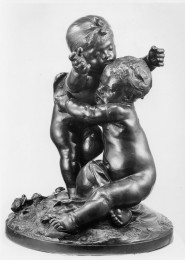 |
Idyll of Ixelles
From 1871 until 1877 — at the beginning of his career — Rodin lived in Brussels. He went there to work on architectural sculpture for buildings including the Bourse (stock exchange), the music conservatory, and the Palais-Royal at the Palais des Académies. He and another sculptor established a partnership and studio in the village of Ixelles, a pleasant suburb of Brussels. The sculptures they made were for revival-style buildings and were largely Rococo in inspiration and allegorical in meaning. Idyll of Ixelles, whose name commemorates where it was made, is composed of two chubby infants. The standing figure, a female, has wings, while the second figure is male. The contrast between the smooth surfaces of the infants’ bodies and the minute detail of their hair and playthings attest to Rodin’s interest in expressive surfaces. The female is directly related to another figure, Science, made for Brussels’ Palais des Académies in 1874.
Incidentally, Rodin made a marble version of Idyll of Ixelles. |
Faithfulness to nature as he conceived of it
Rodin refused to idealize his subjects. He chose to show his people as he found them, old and wrinkled or young and voluptuous. He believed all of nature was beautiful and that any artist who tried to improve upon nature by adding “green to the springtime, rose to the sunrise, carmine to the young lips…creates ugliness because he lies.” [Rodin on Art and Artists, Conversations with Paul Gsell] He often spoke and wrote about his belief in nature and its systems and about how he used naturalism as a powerful expressive element in his work.
Examples:
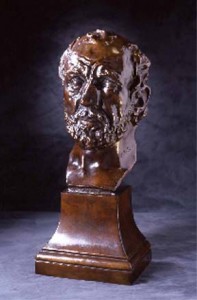 |
Mask of the Man with the Broken Nose
In 1865 — early in his career — Rodin submitted this piece (the model was Bibi, a neighborhood handyman) to the Paris Salon. Unconventional in its partial head and the ugliness of its face – especially its battered nose – Mask was anathema to the jury’s notion of aesthetic “beauty” and it was therefore rejected.
Rodin told one of his supporters:
That mask determined all my future work. It is the first good piece of modeling I ever did. From that time I sought to look all around my work, to draw it well in every respect. I have kept that mask before my mind in everything I have done. I tried it on my first figure, “The Bacchante,” but did not succeed. I tried it again on “The Age of Brass [Bronze],” also without success, though it is a good figure. In fact, I have never succeeded in making a figure as good as “The Broken Nose.”
One might be surprised to learn that, based on forensic examination, it is estimated that Bibi was in his 30s when he posed for Rodin. |
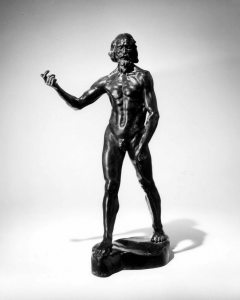 |
Saint John the Baptist Preaching
In 1913 Rodin spoke of what happened when an Italian peasant from the Abruzzi region came to his studio to offer himself as a model:
As soon as I saw him, I was filled with admiration; this rough, hairy man expressed his violence in his bearing, his features and his physical strength, yet also the mystical character of his race. I immediately thought of a Saint John the Baptist, in other words, a man of nature, a visionary, a believer, a precursor who came to announce one greater than himself. The peasant undressed, climbed onto the revolving stand as if he had never posed before; he planted himself firmly on his feet, head up, torso straight, at the same time putting his weight on both legs, open like a compass. The movement was so right, so straightforward and so true that I cried: ‘But it’s a man walk-ing!” I immediately resolved to model what I had seen…. That’s how I came to make The Walking Man and Saint John the Baptist, one after the other. All I did was copy the model that chance had sent me.
|
 |
Balzac in a Dominican Robe
Honoré de Balzac (1799–1850) was a critically acclaimed, very popular French novelist and playwright. He was best known for his stories and novels that told of French life after the fall of Napoleon. His characters were new to European literature – they were complicated and often ambiguous. His realism has been said to have influenced writers like Zola, Dickens, Proust, Dostoyevsky, and Poe, as well as the more contemporary Faulkner, Kerouac, and Calvino.
In 1891, the Committee of the Société des Gens de Lettres de France (Society of Men of Letters of France) commissioned Rodin to create a monument to the writer. Pursuant to the creation of the monument – which was to be sited conspicuously in the middle of the Place du Palais Royal – during the next seven years Rodin made more than 50 studies for the piece, testimony to his interest in absorbing naturalism. Later the sculptor was to say, “Never has a statue caused me more worry, put my patience more to the test.”
Balzac in a Dominican Robe presents some of the realities of the writer’s life, the monk’s robe, his favored apparel when writing, and the pile of books and papers at his feet. |
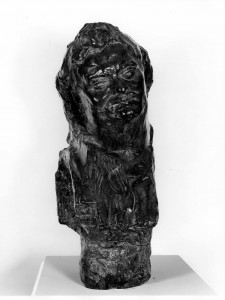 |
Bust of Young Balzac
When Rodin received a major commission, his working method was to get to know its possibilities, literally from the inside out. Thus, many studies exist for his large and complicated pieces (Monument to Victor Hugo, The Burghers of Calais, etc.). These studies typically were examinations of parts of the body, like the hands or the heads; or of the entire figure, unclothed or clothed. If they resulted in works that were popular with critics and the public, the studies were cast in bronze and were for sale, usually in various sizes (thanks to the Collas machine and skilled studio assistants).
Like the Balzac figure above, this bust of Balzac was modeled in preparation for Rodin’s Monument to Honoré de Balzac. In working on this piece, Rodin sought to know and understand not only the writer’s creative genius, but also how he looked. Balzac had died forty years earlier and, although a few very early photographs of him existed along with some portrait drawings and paintings as well as written descriptions, Rodin wanted a better understanding of the writer’s physical appearance. So he went to Balzac’s hometown and found someone there who resembled the Balzac of the existing evidence, and then hired this man to model for the portrait heads. |
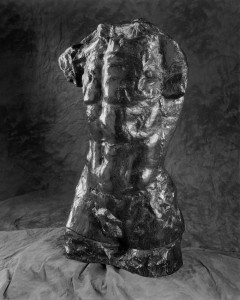 |
Monumental Torso of the Walking Man
This torso and related pieces (see below) attest to Rodin’s interest in ancient Greek and Roman sculpture, pieces of which were often excavated as fragments and/or with mineral accretions. The Torsos confirm the artist’s conviction that partial figures can convey emotional meaning and aesthetic pleasure. They also confirm his interest in Michelangelo. |
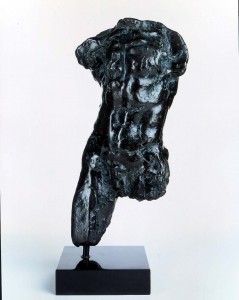 |
Torso of the Walking Man
Both this partial figure and the one above began as studies of a model’s torso in preparation for Saint John the Baptist Preaching (also shown above). In the sculpture studio, an armless and legless torso was easier to experiment with – seeking to represent movement by the surface modeling, the contours, the musculature – than a torso with the arms and legs attached would have been. It was not until Rodin had figured out how use the Saint’s torso to represent movement that he attached arms and legs.
Rodin also used these Torsos as studies for his much admired and influential Walking Man |
The transformation of monumental public sculpture
Along with many of his contemporaries, Rodin sought work and recognition by competing for commissions for public monuments. Once his talent was recognized, he received numerous commissions, resulting in work such as The Burghers of Calais and The Monument to Balzac. He revolutionized the public monument by departing from the academic standards of his day in favor of emotional poses and symbolic themes. Often multi-figured monuments became sources for single figures that were presented as independent sculpture.
Examples:
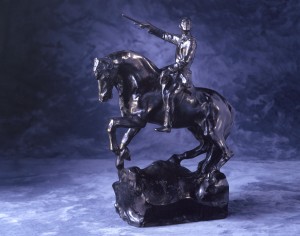 |
Maquette for the Monument to General Lynch
Rodin received a number of commissions for monuments to commemorate the public lives of admired and important men. From Balzac, Hugo, Claude, and Bastien-Lepage, to Whistler and Lynch, the sculptor saw these major commissions as opportunities to innovate and to improve on what had been done in the past.
General Patricio Lynch Solo de Zaldivar (1824-1886) was a Chilean hero of the War of the Pacific between Chile and Peru (1879-1883). Rodin’s maquette reveals his intention to sculpt an equestrian monument that would rival those already famous: Donatello’s Gattamelata and Verrochio’s Colleoni, as well as the Marcus Aurelius in Rome and Bernini’s Louis XIV in Versailles. Intended to stand atop a rectangular pedestal, the piece gets its life from the horse. The animal’s spirited pose portrays Lynch as a dynamic military leader in a way the figure alone does not.
Eventually, the project for the Monument to General Lynch was abandoned. |
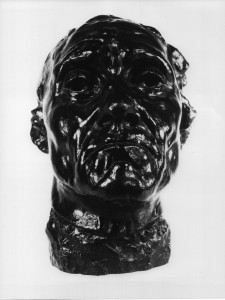 |
Monumental Head of Jean d’Aire (from The Burghers of Calais)
The history of the 1347 siege of Calais was well known in Rodin’s time. It was told in Jean Froissart’s (1335-1400) Chroniques, a first-hand history of the Hundred Years War between England and France. Froissart wrote that when the mayor of Calais reported to his people the English king’s conditions for ending the city’s siege:
They all began to cry and weep, so much and so bitterly that there is no heart in the world so hard that having heard and seen them would not have pitied them…
A moment later there arose the richest burgher, Sir Eustache de Saint-Pierre, who said: “Lords, it would be a great misfortune to let such a people die here of famine when one can find another means. I have such hope of finding grace and pardon from Our Lord if I die in order to save these people, that I want to be the first: I will willingly strip to my shirt, bare my head, put the rope around my neck, at the mercy of the king of England.”
In the process of completing his Monument to the Burghers of Calais, Rodin made many studies of the models, both nude and clothed. He did the entire figures and parts of the figures, such as hands and heads. When the finished Monument proved to be very popular, there was a market for these studies, not only to-size but also enlarged and reduced in size. |
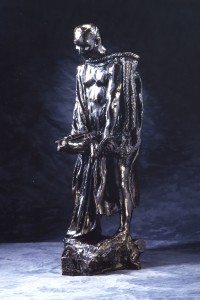 |
Jean d’Aire (Second Maquette) (from The Burghers of Calais)
This version of Jean d’Aire exists because of Rodin’s working method: Figures were first modeled nude so the sculptor could be sure the entire body expressed the sought-after emotion. Only when Rodin was sure of the expressiveness of the nude would he do another piece where the figure was clothed. This nude Jean d’Aire is emaciated and thus conveys the deprivation of his besieged and starving city. He is also stolid and determined, expressing courage and resolve in the face of death.
Jean d’Aire holds a cushion on which lie the keys to the city, their surrender being one of the demands of the English king. |
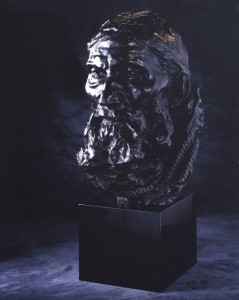 |
Final Head of Eustache de St. Pierre (from The Burghers of Calais)
When contemplating a head that would convey the character of this civic hero, Rodin may have used as a model his friend the painter Jean-Charles Cazin, a descendant of Eustache de St. Pierre. |
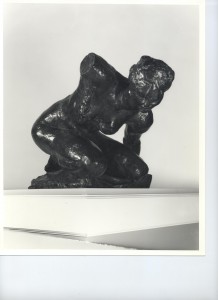 |
Tragic Muse (from The Monument to Victor Hugo)
The Tragic Muse was originally created for Rodin’s Monument to Victor Hugo. In preliminary early studies for the Monument she was placed above and behind the writer, on his right, leaning toward him to inspire. By his third maquette for this monument, however, Rodin had eliminated this figure. In 1895 Tragic Muse, by-then an independent figure and enlarged, was shown for the first time, in Geneva. The museum there commissioned its own cast of the piece, now called Crouching Woman; it was likely this cast that occasioned one P. Seippel to write:
She emerges out of the rock. The rock gives birth to her. She seems to be making a desperate effort to free herself from the stone womb that has borne her and brought her into being. Leaning toward the poet…she bawls her vigorous call to life loud enough for her voice to be heard above the noise of the waves. Isn’t the symbol marvelously clear? The effort made by this child of the rock, born in great pain, is the effort of thought, rising into the light from the darkness of the subconscious. Seippel may have written this in defense of Crouching Woman, whose nudity scandalized Geneva’s conservative audiences.
Rodin reintroduced The Tragic Muse in his fourth version of The Monument to Victor Hugo. Finally, in 1905, he stopped including it entirely. |
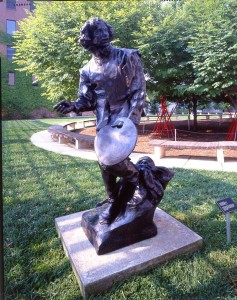 |
Claude Lorrain (from The Monument to Claude Lorrain)
Claude Gellée, known as Claude Lorrain, was perhaps the most important Seventeenth-Century French-born painter. He was a landscape painter when painting landscapes was not considered to be of great importance. Accordingly, he disguised his landscapes by inserting figures, and he gave his finished paintings historical or narrative titles – thus providing his work with the “moral weight” required at the time. Two hundred years after Claude’s death, his native city of Nancy invited Rodin to participate in a competition for a monument to the painter. For inspiration Rodin went to what he perceived to be Claude’s greatest interest, the landscape of light.
The figure was meant to be set high atop a pedestal that was unconventionally enlivened at its base by the figure of Apollo, the sun god, driving his chariot across the sky each day, creating the passage from dawn to sunset. Accordingly the figure of Claude is caught in mid-step, rotating his body to glimpse the rising sun, the source of his delight in nature. A viewer standing below would see Claude twisting and turning, his face in awe at the sight. In this illusion of movement, the painter’s serpentine figure itself would capture light and thus emulate the intentions of the painter. |
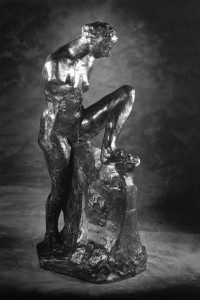 |
Study for the Monument to Whistler
Rodin’s career proved the point that innovation is not easy. Almost every important piece he did stirred up some kind of controversy. Case in point: The Monument to Whistler.
In December 1903 Rodin was elected President of the International Society of Sculptors, Painters, and Gravers, succeeding James McNeill Whistler, who had served as its first president. Soon the Society asked Rodin to “to make some monument to Whistler.” It suggested a theme of “Winged Victory symbolizing Whistler’s triumph – the triumph of Art over the Enemies.” (Whistler had notoriously sued critic John Ruskin for libel after the latter accused him of “flinging a pot of paint in the public’s face.”)
By 1908 Rodin’s Monument appeared much as it does in this small study. The critics argued about its merit. One wrote,
Imagine a woman, a sort of woman, standing, the left leg raised, leaning on some rock; and this woman looks at her left foot; she would look at it at least, if she had eyes. Why she shows interest in this inferior member [her foot] one doesn’t know… The neck is an absurd cylinder. The head is that of a brute…Rodin never ends by completing an ensemble.
A fervent Rodin supporter defended the Monument, drawing attention to its relationship to the Louvre’s ancient Greek sculptures, often seen in fragmentary states.
The result here is equal to the works of Greece; there is the same plenitude, the same vital force of the modeling. I understand how people might regret the lack of arms. It is understandable and I would like to regret them also. But before regretting what isn’t there, permit us to admire what is there: a masterpiece, a great masterpiece.
Of course, the great innovation of this piece is that it is likely the first memorial that does not include a portrait of the person being honored. |
Treating partial figures and fragments as complete works of art
Rodin was one of the first artists to insist that part of a figure – such as a torso or a hand – could by itself convey meaning and thus would be a complete work of art. He found inspiration for this in the power and formal beauty he saw in the fragments of Classical Greek and Roman sculpture that were at the time being discovered by archaeologists. Rodin’s partial figures went on to greatly influence modern sculptors at the beginning of the Twentieth Century — artists like Maillol, Brancusi, Archipenko, and Matisse. These artists and others ran with the freedom his work gave them.
Examples:
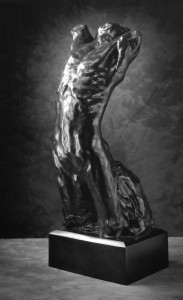 |
Narcisse
This piece is a good example of the issues that complicate the study of Rodin sculpture: It was not included in The Gates of Hellwhen the models for the doors were first shown, but it was included in a later model. Rodin also showed it as an independent figure, in versions both enlarged and reduced in size (sometimes it was 10 inches, sometimes 17). Some variations of Narcisse combine it with other figures; at other times it has arms. Rodin even used a reduced version of the figure as the handles on a ceramic vase (it is easy to imagine the pleasure of holding the backward-leaning figure in one’s hand).
Rodin exhibited the 32-inch enlargement of this design as Narcisse, the Greek god who fell in love with his own striking reflection in a pool. Enchanted by his own good looks, he was unable to leave and soon died. |
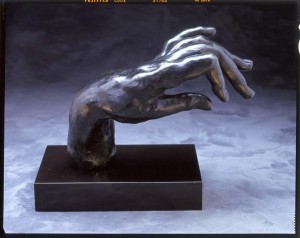 |
Large Hand of a Pianist
Rodin was fascinated by the expressive capabilities of hands. He modeled hundreds of them, using them both as independent sculptures and as parts of more complex pieces. By carefully modeling their musculature, proportion, texture, and balance, he demonstrated that hands could convey profound emotion, from anger and despair to compassion and tenderness.
When Rodin composed a new figure, he often experimented by attaching to it hands made for earlier pieces in order to explore the possibilities the new combinations might reveal. This working method also encouraged Rodin’s interest in the fragment and inspired his exploration of the notion that figurative sculpture need not depend on a whole figure to communicate meaning.
One of the characteristics of modern art is that it makes visible things that are not tangible, like energy, sound and rhythm – all of which are implied by Rodin in his Large Hand of a Pianist. It is not known whose hand this is; what is apparent is that the sculptor elongated the fingers to make visible the music being played so effortlessly. |
 |
Large Clenched Left Hand
Rodin did many hands that appear to be crippled by disease, like Large Clenched Left Hand. They have fascinated physicians, especially hand surgeons, for decades. In spring 2014 The Cantor Center for Visual Arts at Stanford University collaborated with a hand surgeon at Stanford’s Medical School to examine what could be diagnosed from Rodin’s hands. |
Recycling figures: marcottage and assemblage
Throughout his career Rodin recycled his own works. The complicated process of bronze casting provided him with multiple leftovers — arms, legs, small figures, etc. — both in bronze and in plaster. He experimented with the reuse of these, often creating entirely new works by combining existing parts. If a new work was made of pieces put together from diverse existing works, it was called a marcottage. He also pioneered the technique of repeatedly casting the same figure and then using the multiple casts together in one to make a new work; this was called an assemblage.
Examples:
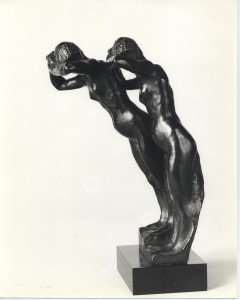 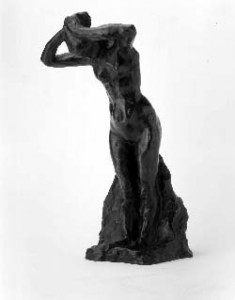 |
The Night (Double Figure) and Standing Female Nude Combing Her Hair (aka The Night [Single Figure]) (both assemblages)
At first glance, these two pieces appear to be identical except that one of them is two figures. If you look very closely, however, you will find there is another difference: the placement of the arms.
In Standing Female Nude Combing Her Hair – the single figure – the arms are raised above her head. After finishing it, Rodin worked on another piece, The Tower of Labor (never completed). He decided he wanted two figures to be placed in front of the door of the Tower. He used the existing Standing Female Nude Combing Her Hair as the basis for one of these. He moved the arms of the original figure, placing them in front of her face, and then used two casts of her to make the new piece, The Night.
Had The Tower been completed including the assemblage The Night, the larger piece would have been a marcottage.
|
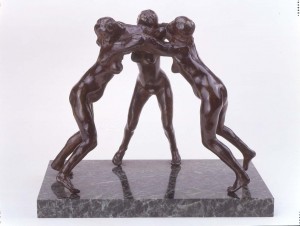 |
Three Faunesses (assemblage)
What appears to be three mythological creatures joined in a circle is actually a single figure cast three times and then braised together.
Long identified by this or similar titles, there is nothing about these woman to identify them as faunesses (mythological creatures usually depicted as half-goat). In his choice of title for this piece, Rodin perhaps sought to emphasize what he saw as the pagan instinctual nature of the women who dance together and forget all else. |
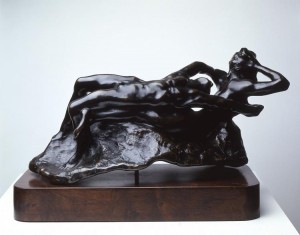 |
Fugitive Love (marcottage)
This piece is a marcottage of two existing figures, one from Ugolino and His Sons. Everyone admired this piece: the public, critics and patrons, and Rodin himself. It began its life on The Gates of Hell. Here it appears twice, once horizontally, once vertically. And here it was titled Fugit Amor (Fugitive Love). When it was shown independently of the doors, it was variously called The Sphinx, The Dream, Passing Love, and The Chimera. There were also numerous marble versions of this work.
Rodin considered Fugitive Love to be worthy of admiration, and he gave it to a number of people who were important to him and his career. Among these fortunate individuals were Gustave Larroumet, director of the Ministry of Fine Arts (1895), which had just commissioned The Monument to Victor Hugo; Jean Aicard, who supported Rodin in the Balzac controversy; and Etienne Clémentel, who encouraged Rodin in the creation of his museum.
When it was part of The Gates of Hell, this piece spoke of unrequited love. But when it was separated from The Gates, the understanding of its meaning changed somewhat. Now it favored a more Symbolist interpretation of woman as temptress, as the source of evil, as the cause of men’s misfortune (as in Baudelaire’s The Flowers of Evil and in Edvard Munch’s paintings and prints from the same period). |
Embracing accident and chance
The chance appearance in his studio of a model who showed unexpected possibilities for body type and pose, the cracking of a clay portrait head that transformed it into a mask, the unlikely influence of a studio prop, all of these were for Rodin part of his creative inspiration. Unlike his predecessors, when he began a piece he did not necessarily know what it would mean and how it would look when it was finished. Instead, he embraced the on-going inspiration of accident and chance.
Examples:
 |
Saint John the Baptist Preaching
In 1913 Rodin spoke of what happened when many years earlier an Italian peasant from the Abruzzi region came to his studio to offer himself as a model:
As soon as I saw him, I was filled with admiration; this rough, hairy man expressed his violence in his bearing, his features and his physical strength, yet also the mystical character of his race. I immediately thought of a Saint John the Baptist, in other words, a man of nature, a visionary, a believer, a precursor who came to announce one greater than himself. The peasant undressed, climbed onto the revolving stand as if he had never posed before; he planted himself firmly on his feet, head up, torso straight, at the same time putting his weight on both legs, open like a compass. The movement was so right, so straightforward and so true that I cried: ‘But it’s a man walk-ing!” I immediately resolved to model what I had seen…. That’s how I came to make The Walking Man and Saint John the Baptist, one after the other. All I did was copy the model that chance had sent me.
|
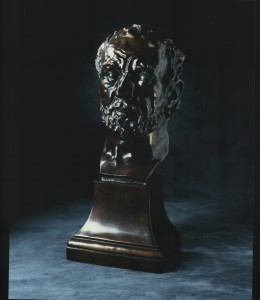 |
Mask of the Man with the Broken Nose
During the winter of 1863-1864 the young sculptor was working on a fully-in-the-round clay head of a local handyman, Bibi. One night the temperature in Rodin’s meager studio plummeted and the wet clay froze, causing the back of the head to crack and break off. Thus, the head was transformed into a mask.
Always receptive to the serendipity of accident and even this early in his aesthetic development interested in the notion that part of a figure could have full expressive capabilities, Rodin considered the Mask to be exhibition-worthy. In 1865 he submitted it to the Paris Salon. The partial head and the ugliness of the face – especially its battered nose – made the Mask anathema to the jury’s notion of aesthetic beauty and it was rejected. (Ten years later Rodin submitted a marble version of the Head – not mask – of the Man with the Broken Nose and it was accepted, the first Rodin to be admitted to this conservative and very important annual Parisian art exhibition.) |
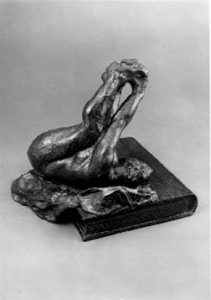 |
Ecclesiastes
It is thought that Rodin first created this assemblage before 1899. In 1900 it was called Woman with a Book. In 1903 the Symbolist poet, and art collector Robert Montesquiou described the figure differently, seeing her as “crushing and shattering a book of science with her nudity.” In 1904 the piece was exhibited with the title Ecclesiastes and the critic Georges Grappe explained this title as an allusion to the vanitas vanitatum cited in the scriptures (Ecclesiastes 1:2, 12:8): “All is vanity.”
Woman with a Book is certainly the most literally descriptive of the titles assigned to this small, disarming piece, and it probably explains the process of the work’s creation. No doubt Rodin, a champion of the value of chance, modeled the small figure and then looked around for something to hold it up. Thus, the book was first used as a pedestal, next was transformed into an element that added meaning to the piece, and finally was cast in bronze along with the figure. |
Activating the space around the figure
Rodin was a man of his time, and during his later life the notion of movement through time and space influenced literature, philosophy, and daily life (think of the coming advent of the motion picture and the motor car). We can often find indications of the passage of time in his work. He also was aware that sculpture could physically engage its audience in physical ways. Thus his greatest works invigorate and involve the locations they inhabit.
Examples:
 |
Fallen Caryatid with Stone
In 1897 Rodin’s secretary, the poet Rilke, wrote of the Caryatids:
On each part of this body, the entire rock rests like a will that was greater, more ancient and more powerful, and yet its destiny, which was to carry, has not stopped. It carries, as one carries the impossible in a dream, and cannot find a way out. And despite its collapse, its weakness, the act of carrying continues, and when exhaustion strikes again, forcing this body to recline, even when reclining, it will still carry, will go on carrying forever.
The implication of the potential for movement by this coiled figure activates the space around it in a remarkable way, reminiscent of Michelangelo yet wholly original too. |
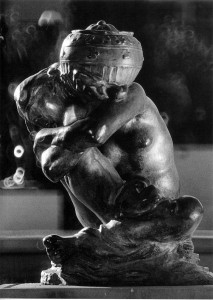 |
Fallen Caryatid with Urn
We are reminded of the timelessness of Rodin’s work, as well as of Rodin’s own words (above) when one of the characters in Robert Heinlein’s influential 1961 science fiction novel, Stranger in a Strange Land, says:
This poor little caryatid has fallen under the load. She’s a good girl — look at her face. Serious, unhappy at her failure, not blaming anyone, not even the gods…and still trying to shoulder her load…. She’s a symbol for every woman who ever shouldered a load too heavy. But not alone women – this symbol means every man and every woman who ever sweated out life in uncomplaining fortitude until they crumpled under their loads. It’s courage…and victory… She’s a father working while cancer eats away at his insides, to bring home one more paycheck. She’s a twelve-year-old trying to mother her brothers and sisters because mama had to go to Heaven…She’s all the unsung heroes who couldn’t make it but never quit.
|
The sexual candor of his work
Never one to shy away from controversy and with his own well-known sexual appetite as well as the belief that the creation of art, like the procreation of people, was a god-like endeavor, Rodin used sensual contours, the silkiness of bronze, and poses that expressly revealed genitalia to engage the viewer and titilate the potential collector. He also joined others in the avant garde of his day by depicting lesbian love.
Examples:
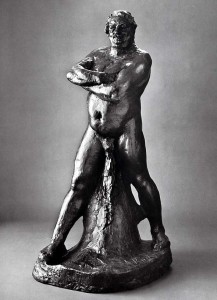 |
Nude Study of Balzac (Type C)
Balzac was renowned for his corpulence, his appetites, and the disproportion of his body (his legs were short). Rodin scholar Albert Elsen points out that in fulfilling his commission Rodin took on the task of “creating for an impatient committee of sculpturally unsophisticated writers a heroic public monument destined for the heart of the nation’s capital. The subject of this daunting effort was a short fat, ugly man who wrote books.”
In this preparatory study, Rodin gives Balzac more physical strength and sexual vigor than he perhaps really had, perhaps suggesting the writer’s intellect could inform his physique. |
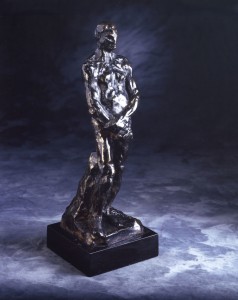 |
Study for Balzac (Type B)
This bronze “sketch” shows the writer as thinner and more attractive, with a graceful curve to his back. |
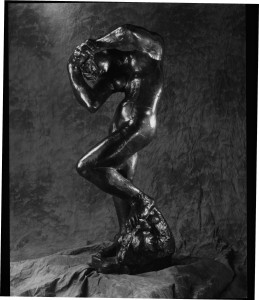 |
Meditation (With Arms)
This figure, which displays a Michelangelesque tendency to combine the masculine and the feminine, is also an amalgam of Rodin and art nouveau, the premiere avant-garde style in decorative and graphics arts during the late-Nineteenth and early-Twentieth centuries. One need only look at paintings and drawings by Klimt and Mucha to see the similar erotic undertones. |
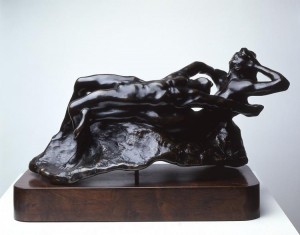 |
Fugitive Love
When it was part of The Gates of Hell, this piece spoke of the hell of unrequited love. But when it was separated from The Gates, its meaning changed somewhat. Now it favored a more Symbolist interpretation of woman as temptress, as the source of evil, as the cause of men’s misfortune (as in Baudelaire’s The Flowers of Evil and in Edvard Munch’s paintings and prints from the same period). |
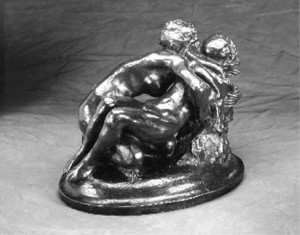 |
The Metamorphosis of Ovid
Ninteenth-Century Romantic artists explored many themes that had been previously taboo. One such theme was lesbianism. Rodin (along with painters Courbet, Degas, Toulouse-Lautrec, and others) drew people to their work by using the theme’s then-capacity to shock.
Rodin did a number of pieces with a lesbian theme in the mid-1880s. The Metamorphosis of Ovid was exhibited often, but – so typical of Rodin – under a variety of titles, The Satyresses among them. The current title was not bestowed until 1899. It was a very popular work, both in its bronze and marble versions.
In 1914 a gallery catalogue described it: “One, coiled up, hunches her body like a tight spring, her legs tense, her back rounded, while beneath her reclines her conquest in the most passive abandonment….” |
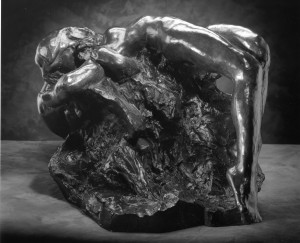 |
Illusions Received by the Earth (The Fallen Angel)
Rodin’s practice during the 1890s emphasized reusing figures and parts of figures he had made during the 1880s: He combined existing parts to create new wholes. Illusions Received by the Earth is a prime example of this working method. The crouching figure is the Fallen Caryatid with Stone; the stretching figure is Portrait of Adele.
Because of how a bronze sculpture is cast, the “reusing” of elements from earlier pieces is technically easy. Rodin’s studio was filled with white plaster figures, torsos, arms, legs, and hands, remnants of the process of casting earlier pieces. One visitor likened the studio to a cemetery of bones. |
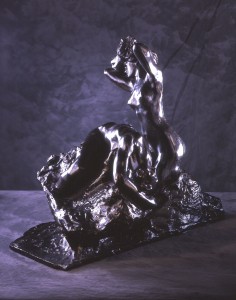 |
Toilette of Venus and Andromede
Curator David Steel of the North Carolina Museum of Art writes of this piece with its lesbian subject:
Rodin created this assemblage by combining two previously independent pieces: Andromeda, a marble carved in 1885, from which the mold for the bronze was made, and Toilette of Venus, modeled about 1890….
There is no obvious narrative or iconographic connection between Venus and the Ethiopian princess Andromeda and equally little direct link between the two sculptures and their mythological counterparts. What may have inspired Rodin to bring together the two figures is the contrasting ways their poses express the inherent energy contained in the human body. The figure of Andromeda is compacted, wedded to its rocky support, which has been abruptly tilted upward. The form’s energy is contained in as small an area as possible. The upright figure of Venus releases her energy as she arches her back and stretches her torso. It is almost as if the somnolent figure of Andromeda has risen from her slumber and stretches as she awakens.
|
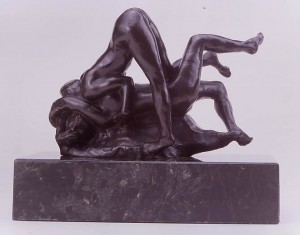 |
Damned Women
Damned Women was never exhibited during Rodin’s lifetime. Notes Rodin scholar Antoinette Romain, this was “due to the blatant eroticism that makes the group one of the sculptor’s boldest works. [In 1893 Proust] …suggested that a woman predisposed to Sapphic love might be encouraged [in this love] by the sight of ‘some of Rodin’s statues,’ since they would help her to ‘[overcome] – artistically – her reluctance.'”
|
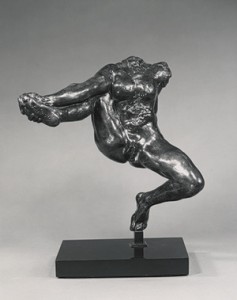 |
Iris, Messenger of the Gods
That freedom of expression was paramount in Rodin’s work can be seen in this piece, with its extraordinary leaping pose, revealed female genitalia, and obvious joy in movement. Probably modeled from the poses of a cancan dancer-model, Rodin’s bronze is a testament not only to his interest in big gesture, but also to the world of demimonde pleasures that surrounded him and his circle in the late Nineteenth Century.
The sculptor Maillol called this the finest work Rodin ever did. Part of its capacity to astonish comes from its upright position. Were Iris lying on her back, the viewer would be a voyeur; instead, the viewer is a participant in its dynamic and powerful motion.
This piece was very popular during Rodin’s life and immediately after his death. Many casts were commissioned and sold for among the highest prices paid for bronzes of this size. |
He had a well-organized workshop with thoroughly-trained craftspeople
At the height of his fame Rodin had more than 50 people in his employ. They were trained to help him in various ways: some were specialists, others not. Some made his plaster molds, some carved the marble pieces, some assisted in the marcottage process, some worked with the off-site foundries, some were patiners, some created the enlargements and reductions so vital to his income. Because of the high cost of making a bronze, very few pieces were done to have on hand in case a collector dropped in. Instead, works were done on specific commission and could be made at any size desired by the purchaser. His gallery and salesroom were in Paris, in today’s Musée Rodin.
Rodin biographer and scholar Ruth Butler has pointed out that what made Rodin the most popular sculptor of his period was that he worked in bronze, which made possible large numbers of multiple originals; Rodin’s large workshop made as many casts of his pieces as could be sold. For instance, between 1898 and 1918, at least 319 casts of The Kiss were produced. It was among his most popular pieces and was available in four sizes. During the artist’s lifetime there were neither the limited editions nor the numbered casts required today by French law. In short, Rodin was everywhere.
He was an expert at what today we call marketing (his work and himself) and he actively sought fame
During Rodin’s life there were scores of art writers, art critics, and periodicals that included or featured the arts. Because not everyone appreciated Rodin’s work, the controversy it often stirred gave him even more publicity than that ordinarily accorded a popular artist. Plus he wrote about his work and of his other aesthetic interests, granted countless interviews to those from France and further afield, and sent his works all over Europe, Britain, and even to America for exhibitions. He was active in artist associations, too, and also made portraits of some of his era’s most important personalities, following the advice of Bazire: the way to further his career and reputation was to exhibit the portrait of a famous man.
Examples:
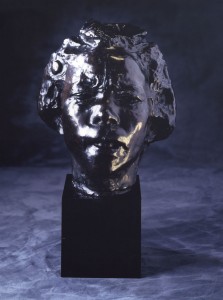 |
Mask of Hanako
Whereas his contemporary Degas was interested in dancers as subject-matter, Rodin was interested in dancers for what they taught him about how the body worked and moved. In 1906, in Marseilles to study the Royal Cambodian dancers, he met the Japanese dancer and actress Ohta Hisa (1868-1945), who had been nicknamed Hanako (“Little Flower”) by another dancer, the American Loïe Fuller. Hanako was renowned for her astounding coordination and her ability to hold a difficult position. Beginning in February 1907 she posed for Rodin; he made at least 53 heads plus several drawings of her.
Rodin’s friend and biographer Judith Cladel described one of Hanako’s sittings: “Hanako did not pose like other people. Her features were contracted in an expression of cold, terrible rage. She had the look of a tiger, an expression thoroughly foreign to our occidental countenances. With the force of will the Japanese display in the face of death, Hanako was able to hold this look for hours.”
First titled Mask of the Anguish of Death, this piece may have been inspired by a death scene the sculptor saw her perform. |
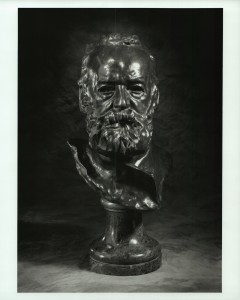 |
Heroic Bust of Victor Hugo
Victor Hugo (1802-1885) was France’s most revered and popular nineteenth century writer and poet. He was also passionately admired by his Third Republic countrymen for his opposition to the Second Empire and his support for the ill-fated Commune of 1879.
Rodin’s portrait of Hugo dates from 1883 and was extremely popular. Many casts were made in bronze and plaster that were both sold and strategically given to collectors, journalists and institutions. Replicas of the bust were also made in marble.
Rodin wrote that Hugo “…had the air of a Hurcules [sic]…[he] belonged to a great race. Something of a tiger or an old lion. He had an immense animal nature. His eyes were especially beautiful and the most striking thing about him.”
After Hugo died in 1885, a public commission for a monument to Hugo was announced; it was eagerly sought by Rodin and others. It was to be placed in Paris’ Pantheon, a monumental classical building, and would bring fame and fortune to the artist whose design was chosen. In September of 1889 Rodin won the commission.
|
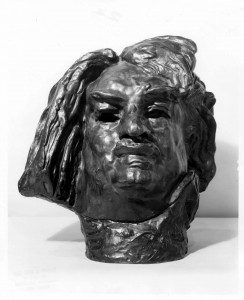 |
Monumental Head of Balzac
Rodin sculpted many heads of Balzac, the acclaimed French writer of the early Nineteenth Century. All were modeled in preparation for Rodin’s Monument to Honoré de Balzac, a commission he received in 1891 and completed in 1898.
In working on his Balzac, Rodin sought to understand not only the writer’s creative genius, but also how he looked. Balzac had died forty years earlier and, although a few very early photographs of him existed along with some portrait drawings and paintings, as well as written descriptions, Rodin wanted a better understanding of his physical appearance. So he went to Balzac’s hometown and found someone there who resembled the Balzac of the existing evidence, and then hired this man to model for the portrait heads. |
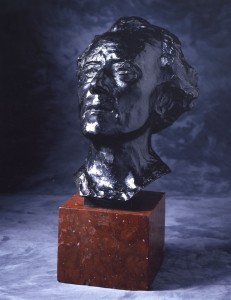 |
Gustav Mahler
The Austrian composer and conductor Gustav Mahler (1860-1911) was one of the most famous cultural figures of his day. A prolific composer, he also conducted orchestras all over Europe and in New York, but his home was Vienna. Rodin, also famous throughout Europe and America, felt especially appreciated by the Viennese. He and Mahler had many mutual acquaintances in Vienna but did not meet until 1910, when friends tricked Mahler into sitting for Rodin.
The two men were strangers with strong egos and they matched each other in celebrity. It was reported that, when they finally faced each other at the sitting, Rodin working in clay and Mahler perfectly still, mutual respect ensued:
They don’t speak to each other, being quite content to observe one another; and yet, they understand each other perfectly…. Of his own accord, Mahler placed himself on the platform and Rodin began to work. Throughout the entire sitting, Mahler remained absolutely motionless. It was interesting to watch his eyes: he looked steadily at the sculptor and seemed to grasp what the latter was doing. [Sophie Clemenceau]
Rodin’s working method can be seen if you look carefully at the face. Beginning with a rough block of clay, he applied small bits of it to create the face. Unlike most artists of his time, Rodin’s method involved adding to an original block, rather than subtracting from it. Look at the forehead and around the eyes: Some of these added bits are still discernable. |
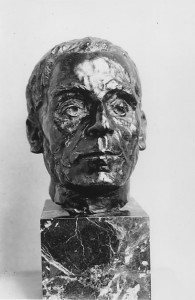 |
Pope Benedict XV
The papacy of Giacomo della Chiesa (1854-1922) began in 1914, coinciding with the beginning of World War I, which he called the “suicide of civilized Europe.” The war and its consequences were his main focus. He attempted to mediate peace in 1916 and 1917 but both sides rejected his initiatives: The Germans deemed any “Papal Peace” insulting and the French regarded the Vatican initiative as anti-French.
Having failed with diplomatic initiatives, Benedict XV sought instead to lessen the impact of the war by focusing on humanitarian efforts: attending to prisoners of war, the exchange of wounded soldiers, and food deliveries to needy people. One of Benedict’s achievements was to promulgate a reorganized and restated Code of Canon Law; it served the Vatican until 1983.
Both Rodin and the Pope were ailing by the time Benedict agreed to sit for the sculptor in 1915 (Rodin was 75; he would die two years later). The artist went to Rome, expecting his usual minimum of 12 sessions with his subject, but the Pope gave him only four. Rodin’s working method of measuring and observing the head from all angles is reported to have made the Italian nervous. Rodin carried his unfinished clay head of the Pontiff back to Paris and completed it there in six days.
Some have suggested that the directness of the head, its depiction of Giacomo the Man rather than Benedict the Pope, is because the number of sittings were so reduced that Rodin was not required to produce an “official portrait” of the Pope. Rodin seems to have conveyed his subject’s vulnerability, not his venerability. If you look carefully, you might see evidence that the Pontiff may have had a stroke before he sat for the artist. |
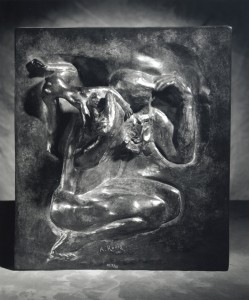 |
The Creator
In a sense, every work an artist does is a self-portrait. Some tell how the artist looks, others tell how the artist feels, and some relate the artist’s aspirations or interests. Some of these self-portraits are literal; others are figurative.
This bas-relief was originally made for the inside of the jamb of The Gates of Hell. It shows a small female figure whispering inspiration into the ear of an elderly bearded man. Rodin used this female personification of inspiration a number of times in his work.
Rodin often spoke and wrote about the creative act. In making art, he said, the artist performs a God-like activity. He related the artist’s creation of his own artwork to God’s creation of the world. And here Rodin makes this personal: In this piece The Creator is an old man who has Rodin’s famous beard. |
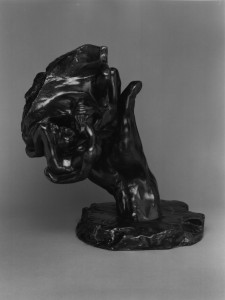 |
The Hand of God
The Hand of God was born of inspiration. As Professor Albert Elsen wrote:
‘When God created the world.’ Rodin once remarked, ‘it is of modeling He must have thought first of all.’ This idea, first documented in an article in the May 1898 issue of the Gazette des beaux-arts, was given tangible form in Hand of God, also known as Creation. Here, Rodin likens the sculptor’s talent to God’s life-giving touch. The large hand holds a rugged, amorphous mass from which the smooth forms of a man and woman materialize. Rodin’s use of the Michelangesque non finito, so prevalent in his marble sculptures, achieves its most meaningful embodiment here. The roughly hewn stone symbolizes the sculptor’s medium as well as primal matter.
Non finito is a sculpting technique literally meaning that the work is unfinished. Non finito sculpture appears unfinished because the artist sculpts only part of the block, leaving the figure to appear to be emerging from an unrefined block of material. |

